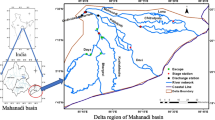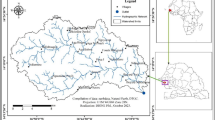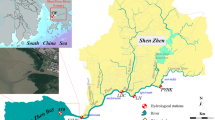Abstract
In the current years, changing the land cover/land use had serious hydrological impacts affecting the flood events in the Kelantan River basin. The flood events at the east coast of the peninsular Malaysia got highly affected in the recent decades due to several factors like urbanisation, rapid changes in the utilisation of land and lack of meteorological (i.e. change in climate) and developmental monitoring and planning. The Kelantan River basin has been highly influenced due to a rapid change in land use during 1984 to 2013, which occurred in the form of transformation of agricultural area and deforestation (logging activities). In order to evaluate the influence of the modifications in land cover on the flood events, two hydrological regional models of rainfall-induced runoff event, the Hydrologic Engineering Center (HEC)-Hydrologic Modeling System (HMS) model and improved transient rainfall infiltration and grid-based regional model (Improved TRIGRS), were employed in this study. The responses of land cover changes on the peak flow and runoff volume were investigated using 10 days of hourly rainfall events from 20 December to the end of December 2014 at the study area. The usage of two hydrological models defined that the changes in land use/land cover caused momentous changes in hydrological response towards water flow. The outcomes also revealed that the increase of severe water flow at the study area is a function of urbanisation and deforestation, particularly in the conversion of the forest area to the less canopy coverage, for example, oil palm, mixed agriculture and rubber. The monsoon season floods and runoff escalate in the cleared land or low-density vegetation area, while the normal flow gets the contribution from interflow generated from secondary jungle and forested areas.















Similar content being viewed by others
References
Bathurst JC, Bovolo CI, Cisneros F (2010) Modelling the effect of forest cover on shallow landslides at the river basin scale. Ecol Eng 36:317–327
Baum R, Savage W, Godt JW (2008) TRIGRS—a Fortran program for 560 transient rainfall infiltration and grid-based regional slope-stability analysis, 561 version 2.0. US Geological Survey 75 1159
Chan NW (2002) Reducing flood hazards exposure and vulnerability in Peninsular Malaysia floods (Edited by Dennis J. Parker). Taylor & Francis Publisher, London
DHI Water and Environment (2007) MIKE 11: a modelling system for rivers and channels: reference manual. DHI Water and Environment 516 p
Drainage and Irrigation Department (DID) (1995) Annual flood report of DID for Peninsular Malaysia. Unpublished report. Kuala Lumpur DID
Drainage and Irrigation Department (DID) (2004) Annual flood report of DID for Peninsular Malaysia. Unpublished report. Kuala Lumpur DID
Drainage and Irrigation Department (DID) (2015) Annual flood report of DID for Peninsular Malaysia. Unpublished report. Kuala Lumpur DID
Godt JW, Schulz WH, Baum RL, Savage WZ (2008) Modeling rainfall conditions for shallow landsliding in Seattle, Washington. In: Baum RL, Godt JW, Highland Groundwater Colloquium 2009 “Groundwater management in Malaysia—status and challenges” (2009) A Report of the Proceedings of the Colloquium held in Putrajaya, Malaysia from 25 to 26 March
Iverson RM (2000) Landslide triggering by rain infiltration. Water Resour Res 36(7):1897–1910
Jamaliah J (2007) Emerging trends of urbanization in Malaysia [online]. Accessed from http://www.statistics.gov.my/eng/images/stories/files/journalDOSM/V104_Article_Jam aliah.pdf Accessed 20 January 2009]
Kergoat L (1998) A model for hydrological equilibrium of leaf area index on a global scale. J Hydrol 212-213:268–286
Lawrence PJ, Chase TN (2007) Representing a new MODIS consistent land surface in the community land model (CLM3.0). J Geophys Res 112. doi:10.1029/2006JG000168
LI-COR (1991) LAI-2000 plant canopy analyzer operating manual. LI-COR Inc, Lincoln, NE
Liu Z, Todini E (2002) Towards a comprehensive physically-based rainfall-runoff model. Hydrol Earth Syst Sci 6(5):859–881
Mineral and Geoscience Department Malaysia (JMG) (2009) Hydrogeological map of the Kelantan River basin. Scale 1:250,000
Neitsch SL, Arnold JG, Kiniry JR, Williams JR (2005) Soil and water assessment tool: theoretical documentation version 2005. Soil and Water Research Laboratory and Blackland Research Center, Temple, Texas
Nurul Fatyhan B (2016) Analysis of lag time for December 2014 flood incident in Kelantan river basin, Malaysia. Bachelor thesis, Faculty of Civil Engineering & Earth Resources, Universiti Malaysia Pahang
O’Donnell G, Ewen J, O’Connell PE (2011) Sensitivity maps for impacts of land management on an extreme flood in the Hodder catchment. UK Phys Chem Earth 36:630–637
Rutter AJ, Morton AJ, Robins PC (1975) A predictive model of rainfall interception in forests. II. Generalization of the model and comparison with observations in some coniferous and hardwood stands. J Appl Ecol 12(1):367-380
Salciarini D, Godt JW, Savage WZ, Conversini P, Baum RL, Michael JA (2006) Modeling regional initiation of rainfall-induced shallow landslides in the eastern Umbria region of Central Italy. Landslides 3:181–194
Satyanarayana B, Mohamad KA, Idris IF, Husain ML, Dahdouh-Guebas F (2011) Assessment of mangrove vegetation based on remote sensing and ground-truth measurements at Tumpat, Kelantan delta, east coast of Peninsular Malaysia. Int J Remote Sens 32:1635–1650
Savage WZ, Godt JW, Baum RL (2004) Modeling time-dependent areal slope stability. In: Lacerda WA, Ehrlich M, Fontoura SAB, Sayao ASF (eds) Landslides. Taylor and Francis Group, London, pp. 23–36
Sellers PJ, Mintz Y, Sud YC, Dalcher A (1986) A simple biosphere model (SiB) for use within general circulation models. J Atmos Sci 43:505–531
Tangang FT, Juneng L, Ahmad S (2007) Trend and interannual variability of temperature in Malaysia: 1961-2002. Theor Appl Climatol 89:127–141
Uhlenbrook S, Roser S, Tilch N (2004) Hydrological process representation at the meso-scale: the potential of a distributed, conceptual catchment model. J Hydrol 291(3–4):278–296
US Army Corps of Engineers (2000) Hydrologic Modeling System (HEC-HMS): technical reference manual. Hydrologic Engineering Center, Davis, CA, p 149
Wan I (1996) Urban growth determinants for the state of Kelantan of the state’s policy makers, Penerbitan Akademik Fakulti Kejuruteraan dan Sains Geoinformasi. Buletin Ukur 7:176–189
Wang K, Li Z, Cribb M (2006) Estimation of evaporative fraction from a combination of day and night land surface temperatures and NDVI: a new method to determine the Priestley-Taylor parameter. Remote Sens Environ 102:293–305
Yeung CW (2005) Rainfall-runoff and water-balance models for management of the Fena Valley Reservoir, Guam: scientific investigations report 2004-5287, U.S. Geological Survey Scientific Investigations Report 2004-5287, p 52
Acknowledgments
The provision of precipitation, water surface and severe water flow data by the Department of Irrigation and Drainage Malaysia (DID), Ampang Jaya Municipal Council (MPAJ), Geospatial Information Science Research Centre (GISRC) and the Slope Engineering Branch of Public Works Department (PWD) Malaysia are highly recognised and appreciated. Certainly, this study was not at all possible without their continuous support.
Author information
Authors and Affiliations
Corresponding author
Rights and permissions
About this article
Cite this article
Saadatkhah, N., Tehrani, M.H., Mansor, S. et al. Impact assessment of land cover changes on the runoff changes on the extreme flood events in the Kelantan River basin. Arab J Geosci 9, 687 (2016). https://doi.org/10.1007/s12517-016-2716-z
Received:
Accepted:
Published:
DOI: https://doi.org/10.1007/s12517-016-2716-z




